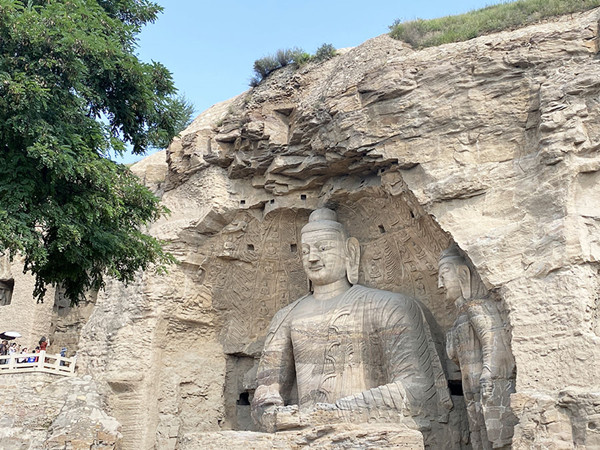Ancient sites in Shanxi's Datong enthrall with rich history


People visit the Yungang Grottoes on Aug 23, 2024. [Photo by Li Ping/chinadaily.com.cn]
The hit Chinese video game Black Myth: Wukong has recently sparked a surge in tourism in North China's Shanxi province. Among the 36 ancient architectural sites featured in the game, 27 are in Shanxi.
The Yungang Grottoes, Huayan Temple and the Xuankong Hanging Temple are three of these historical sites, all in Datong city in northern Shanxi.
Yungang Grottoes, treasure troves of Buddhist art
A trip to Datong wouldn't be complete without exploring the Yungang Grottoes, a UNESCO World Cultural Heritage site.
Yungang Grottoes represent the pinnacle of Buddhist cave art from the 5th and 6th centuries, created during the Northern Wei Dynasty (386-534) when Datong (then known as Pingcheng) was the capital for nearly a century.
Spanning about one kilometer from east to west, the grottoes are carved out of the mountain. A total of 45 major caves and 209 affiliated ones house more than 59,000 sculptures in various sizes, with the tallest standing at 17 meters and the smallest at 2 centimeters. They depict themes from history to architecture and music.
During a tour with the 2024 Shanxi Trip for Taiwan Merchants and Youth on Aug 23, Fan Yang-chi, a journalist from Hsinchu, said: "I only got to truly understand the carving techniques of people and their devotion to Buddhist art after visiting the Yungang Grottoes."
"It's particularly awe-inspiring that the Yungang Grottoes are an artistic achievement that took decades of carving and were jointly created by the imperial family and the common people," he added.
Veteran journalist Cheng Chen-tung also expressed his admiration: "The Yungang Grottoes are very impressive. It's a very important place in Chinese history, an asset of the Chinese mainland, and a crucial cultural heritage on both sides of the Taiwan Strait. It's really stunning. I hope it can be promoted to more people in Taiwan."
Huayan Temple, a cultural gem from the Liao and Jin dynasties
Huayan Temple, originally built in 1038, is among the most well-preserved temple complexes from the Liao and Jin dynasties (916-1234) that still exist in China today, covering an area of 66,000 square meters.
Hailed as an "art museum of Liao and Jin dynasties", the temple contains ancient art treasures of statues and murals, and plays a vital role in Buddhist culture and Chinese architecture.
The main hall of Huayan, the Mahavira Hall, was constructed in 1062 and stands as the largest surviving Buddhist hall from the Liao and Jin dynasties.
While touring the temple on Aug 22, Zhou Hui-lin, a head nurse from Taipei, said: "The Mahavira Hall is magnificent and spectacular when I first saw it. In Taiwan, I haven't seen a Buddhist hall with a history of hundreds of years."
The Grand Hall of Sakyamuni, the oldest preserved structure in Huayan built in 1038, features 29 Liao-dynasty clay sculptures that showcase the high level of statue art from that period. A smiling Bodhisattva in prayer, acclaimed as the "Venus of the East" by Chinese historian Zheng Zhenduo, stands out.
The highest structure in Huayan Temple is the 43-meter Huayan Pagoda, a masterpiece that blends traditional and modern elements, offering visitors a panoramic view of Datong.
Xuankong Temple: the hanging marvel
Xuankong Temple, or the Hanging Temple, is built into a cliff at Hengshan Mountain, about 60 meters above the ground. It stands as a cultural landmark of Datong and a unique example of ancient Chinese architecture.
Constructed during the late Northern Wei Dynasty (386-534), about 1,500 years ago, Xuankong Temple is renowned for its daring location. In 2010, Time magazine listed it as one of the 10 most dangerous buildings in the world.
At first glance, it might seem that the temple is supported by some 30 vertical wooden pillars; the true support, however, comes from horizontal beams embedded in the rock.
"The construction team of the Xuankong Temple is admirable for its boldness and perseverance in architecture. It's astonishing that people from 1,500 years ago had such incredible building skills and techniques," said Fan Yang-chi.







